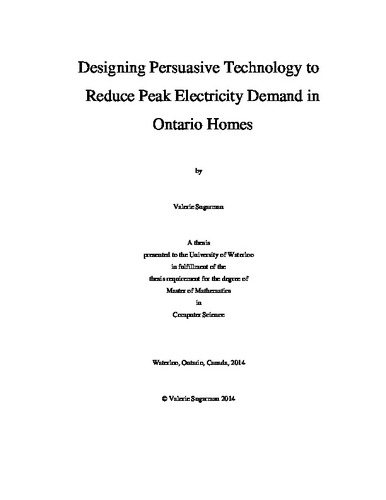| dc.description.abstract | When it comes to environmental sustainability, the time that electricity is consumed matters. For example, using an air conditioner on a hot summer afternoon as the power grid is strained necessitates the use of more polluting sources to meet demand. There are a number of ways to target a reduction in peak demand: better electricity storage technology, for one, has the potential to level out these peaks. In the meantime, electrical utilities aim to incentivize a reduction in demand from households at these times through programs such as Time-of-Use Pricing, and critical peak demand response programs, such as peaksaver in Ontario. However, the effectiveness of these programs has been limited.
In this thesis, we adopted the lens of persuasive technology to improve and support these programs, in order to encourage a reduction in electricity consumption in households at peak load times. To accomplish this, we conducted 18 interviews to examine the practices of households in response to these programs, and learn how they can be improved at the individual level. We found that Time-of-Use pricing encourages shifting some electricity demand, but only when it is convenient. We also found that while potentially effective at a larger scale, the peaksaver program in its current form is unattractive to participants.
We then analyzed our findings using existing behaviour change models, including Fogg’s Behaviour Model for Persuasive Design. Using the three aspects of the model – motivation, ability and triggers - we identified where the existing programs are lacking and developed design implications for the design of persuasive technology to support reducing electricity consumption at peak load times. Finally, we designed a smartphone application based on these design implications, and conducted a preliminary evaluation in order to begin to assess their validity. | en |

